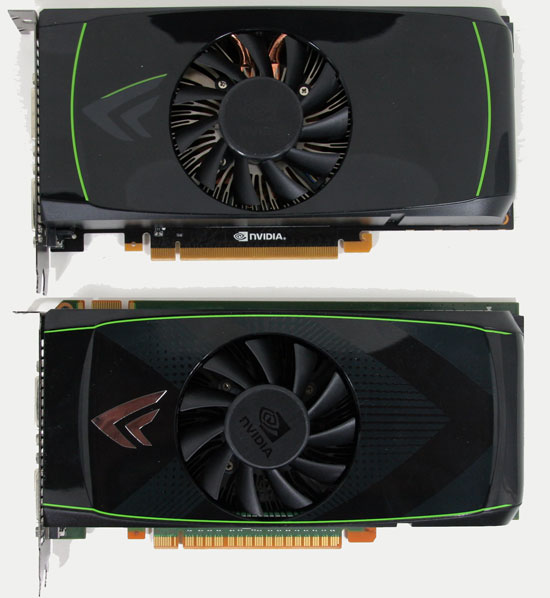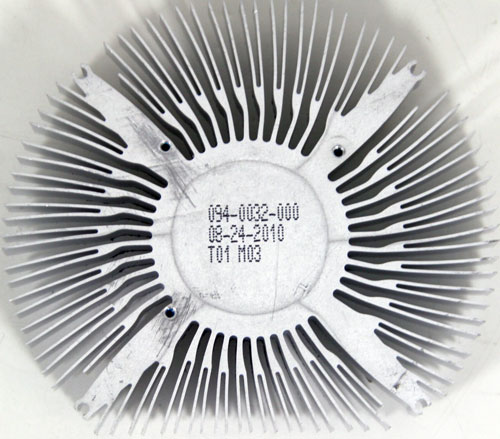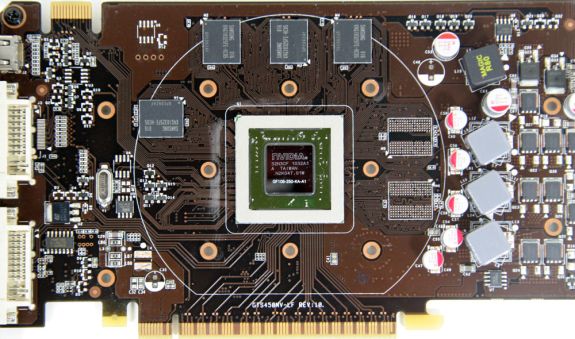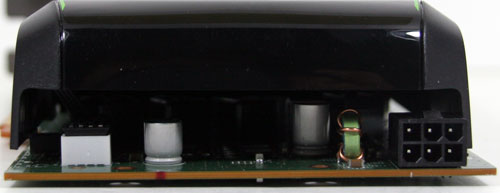NVIDIA’s GeForce GTS 450: Pushing Fermi In To The Mainstream
by Ryan Smith on September 13, 2010 12:02 AM EST- Posted in
- NVIDIA
- Fermi
- GeForce GTS 450
- GF106
- GPUs
Meet the GTS 450
The reference GTS 450 takes a number of cues from the GTX 460, and without labeling on the card it’s actually quite easy to confuse with its bigger sibling. Top-side it uses the same concave shroud and partially-raised fan setup at the GTX 460, and only when you remove these cooling components do you find a simpler circular all-aluminum heatsink between the fan and the GF106 GPU.

Top: GTX 460. Bottom: GTS 450
Since this uses the same cooler design as the GTX 460, it has the same properties: it’s not a fully-exhausting design. The cooler on the reference GTS 450 exhausts towards both the front and the rear of the case, so some degree of case cooling is important. At only 106W TDP this shouldn’t be much of an issue, but there needs to be some airflow within the case.

Meanwhile the PCB and resulting card measure 8.25” long, the same as the GTX 460. This coincidentally is the same length as the reference Radeon HD 5770. The PCB houses pads for 12 GDDR5 memory chips with 6 pads on each the front and back, highlighting the fact that this card isn’t using a full GF106 GPU. With only a 106W TDP, only a single 6-pin PCIe power socket is required to power the card. As with the GTX 460, this socket is rear-facing.
The PCB itself is fairly unremarkable. As is the case with cheaper cards the components are a bit cheaper – you can see a ring-choke near the PCIe power socket. With the card’s fairly low TDP the MOSFETs serving as part of the VRM setup do not require any cooling with the breeze from the fan being enough to cool them at default voltages. The card comes equipped with 8 Samsung GDDR5 memory chips, rated for 4GHz operation. This means there’s a bit of headroom for RAM overclocking if the memory controller is willing to cooperate.

GTS 450 Reference Design PCB (EVGA)

The port configuration remains unchanged from the rest of the 400 series: 2 DVI ports and a mini-HDMI port. The GF106 GPU can only drive 2 displays just like the rest of the Fermi family, so for output options pick any 2 ports. Like the rest of the 400 series, the GTS 400 series is also surround vision capable, so if you have a second card you can SLI them together to gain an additional display output for triple-monitor usage. As this is a lower-end product 3D Vision Surround is not supported due to the lack of performance, but NVIDIA Surround (2D) is supported.

Finally, as was the case with the GTX 460 launch, a number of partners will be launching their own designs today, which we are covering in our companion article that focuses on them. All of these cards are using the NVIDIA reference design or what appears to be a minor variation of it; the big difference on the hardware side of things is the cooler used and bracing methods.










66 Comments
View All Comments
just4U - Monday, September 13, 2010 - link
overclockers is the only review I've seen that shows the 250 in the mix and by the looks of it the 450 is a good 25-30% faster then the 250 on most games they tested with... what reviews are you reading?Personally I see no reason to rush out and buy two of these. A 460 is cheaper and to close in performance to justify it.
marraco - Tuesday, September 14, 2010 - link
http://www.tomshardware.com/reviews/geforce-gts-45...KG Bird - Monday, September 13, 2010 - link
Nice review, but answer one question for me. Why does the HD 5770 scale well in crossfire while others like the HD 5870 don't?heflys - Monday, September 13, 2010 - link
That's one of the great mysteries that has plagued the Crossfire setup. Might just be crappy drivers. Who knows.....Jedi2155 - Monday, September 13, 2010 - link
Do it right...and do it right the first time is the name of the game.OCNewbie - Monday, September 13, 2010 - link
Why would they compare a GTS 450 overclocked to a stock 5770? Wouldn't it make more sense to compare apples to apples, or in this case, OC'd versus OC'd? If you're gonna OC the GTS 450, then wouldn't it be reasonable to expect you'd also OC the 5770? Doesn't the 5770 OC quite well? This is probably even less of a debate, as far as which is the best performer, if you factor in OC'ng to BOTH cards.jabber - Tuesday, September 14, 2010 - link
Most 5770 cards go up to 900/1300 pretty easy.Would leave the 450 even further in the dust however.
Belard - Monday, September 13, 2010 - link
Looks like AMD still has a solid product line of DX11 parts. So an end-user would still be looking at the older 210~250 cards for the $40~80 market.AMD could still easily reduce their prices across the board... but guess they're going to wait until the 6000 series ships and them blow out the 5000 series for cheap.
If the 6750 comes out at $120, but good deal faster than the 5770, that is going to hurt.
KingKuei - Monday, September 13, 2010 - link
So what happened to the Release 260 drivers we were supposed to get this morning?Anand mentioned something about a bug in the driver related to OpenGL (or was it CUDA?) that they were going to fix before releasing it. Yet it's already late afternoon Monday and there's nothing on nVidia's site yet.
The big deal for me actually is related to SC2. SUPPOSEDLY, this is the driver release that fixes many of the issues related to framerate drops in SC2. I care more about that than the GTS 450!
Spazweasel - Tuesday, September 14, 2010 - link
One thing to note: there is a low-profile (double slot) version of this card already available from Palit. I can't find a low-profile 5770. For low-profile cases, this is therefore likely the best you can currently get, and given it's a low-thermal-impact part, this makes sense.The ball is in your court, Powercolor/Sparkle!